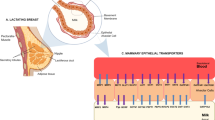Abstract
The absorption and distribution of aminotriazole (3-amino-1,2,4-triazole) in the fetal tissues of mice were studied by whole body autoradiography upon the administration of 14C-labeled aminotriazole. Extraction procedures combined with thin-layer chromatography were used to define the chemical nature of the radioactivity in the fetuses; the effect of aminotriazole on the embryogenesis was also observed. Aminotriazole was passed to the fetuses and the distribution pattern was found to be similar to that of the mothers : the greatest accumulation occurred in tissues with a rapid cell turnover — such as the bone marrow, gastrointestinal mucosa, thymus, and spleen. Most of the aminotriazole was present in the fetus in a non-metabolized form. The administration of 1000, 2500, or 5000 ppm of aminotriazole to the dam's drinking water resulted in a marked decrease in the weight gain of the dams and a pronounced under-deVelopment of the fetuses. Malformations were not observed. It is suggested that aminotriazole participates in some process of rapidly dividing cells which accounts for the reported observations.
Zusammenfassung
Die Aufnahme und Verteilung von Aminotriazol (3-amino-1,2,4-triazol) in den Geweben der Mausföten wurde nach Zufuhr von Aminotriazol — 14C mit Ganzkörper-Autoradiographie studiert. Um die chemische Form der Radioaktivität der Mausföten zu identifizieren, wurden Extrahierungsmethoden in Kombination mit Dünnschichtchromatographie verwendet. Die Wirkung von Aminotriazol auf die Embryogenese der Maus wurde ebenfalls studiert. Aminotriazol war in die Mausföten gelangt und die Verteilung in den Föten war ähnlich derjenigen in den Müttern:
Die höchste Akkumulation fand sich in den Geweben mit schneller Zellteilung — wie Knochenmark, Mucosa des Magen-Darmkanals, Thymusdrüse und Milz. Die Mausföten enthielten das meiste Aminotriazol in einer nicht-metabolisierten Form. Die Zufuhr von 1000, 2500 oder 5000 ppm Aminotriazol im Trinkwasser ergab eine markante Verminderung der Gewichtzunahme der Mütter sowie eine Unterentwicklung der Mausföten. Mißbildungen waren nicht zu beobachten. Es wird vorgeschlagen, daß Aminotriazol an einigen Prozessen von sich schnell teilenden Zellen teilnimmt, was die gemeldeten Beobachtungen zur Folge hat.
Similar content being viewed by others
References
Alexander, N. M.: Antithyroid action of 3-amino-1,2,4-triazole. J. biol. Chem. 234, 148 (1958)
Bartles, P. G., Wolf, F. T.: The effect of amitrol upon nucleic acid and protein metabolism of wheat seedlings. Physiol. Plantarum 18, 805 (1965)
Fang, S. C., George, M., Chang Yu, T.: Metabolism of 3-amino-1,2,4-triazole-5-C14 by rats. J. agric. Food Chem. 12, 219 (1964)
Fang, S. C., Khanna, S., Rao, A. V.: Further study on the metabolism of labelled 3-aminotriazole (ATA) and its plant metabolism in rats. J. agric. Food Chem. 14, 262 (1966)
Gaines, T. B., Kimbrough, R. D., Linder, R. E.: The toxicity of amitrole in the rat. Toxicol. appl. Pharmacol. 26, 118 (1973)
Hapke, H.-J.: Die Giftigkeit von Aminotriazol für Haustiere. Zbl. Vet.-Med. 14 A, 469 (1967)
Hulanicka, D., Klopotowski, T., Bagdasarain, G.: Inhibition of aminoimidazole ribotide biosynthesis in Salmonella typhimurium by aminotriazole. Acta biochim. pol. 16, 127 (1969)
Innes, J. R. M., Ulland, B. M., Valerio, M. G., Petrucelli, L., Hart, E. R., Palotta, A. J., Bates, R. R., Falk, H. L., Gart, J. J., Klein, M., Mitchell, J., Peters, J.: Bioassay of pesticides and industrial chemicals for tumorigenicity in mice: A preliminary note. J. nat. Cancer Inst. 42, 1101 (1969)
Klopotowski, T., Bagdasarian, G.: Partial reversal by purine and pyramidine bases of yeast growth inhibition produced by 3-amino-1,2,4-triazole. Acta biochim. pol. 13, 153 (1966)
Kröller, E.: Anwendung und Eigenschaften des 3-Amino-1,2,4-triazols im Hinblick auf seine Rückstände in Lebensmitteln. Residue Rev. 12, 162 (1966)
Lindauer, W., Salam, N., Sopher, D.: The herbicide 3-amino-1,2,4-triazole (amitrol) as teratogen. Environ. Res. 4, 539 (1971)
Napalkov, N. P.: Blastomogenic effect of 3-amino-1,2,4-triazole. Gig. Tr. prof. Zabol. 6, 48 (1962)
Staples, R. E., Schnell, V. L.: Refinements in rapid clearing technique in the KOH-Alizarin Red. S method for fetal bone. Stain Technol. 39, 61 (1964)
Tjälve, H.: The distribution of labelled aminotriazole in mice. Toxicology (in press)
Ullberg, S.: Studies on the distribution and fate of S35-labelled benzylpenicillin in the body. Acta radiol. (Stockh.) Suppl. 118, 1 (1954)
Ullberg, S.: Autoradiographic studies on the distribution of labelled drugs in the body. Second U.N. Int. Conf. Peaceful Uses of Atomic Energy. 24, 248 (1958)
Wilson, J. G.: Embryological considerations in teratology. In: Teratology, Principles and Techniques (eds. J. G. Wilson and J. Warkany), pp. 251–277. Chicago, Ill.: Univ. of Chicago Press 1965
Wolf, F. T.: Growth inhibition of Chlorella induced by 3-amino-1,2,4-triazole, and its reversal by purines. Nature (Lond.) 193, 901 (1962)
Author information
Authors and Affiliations
Rights and permissions
About this article
Cite this article
Tjälve, H. Fetal uptake and embryogenetic effects of aminotriazole in mice. Arch. Toxicol. 33, 41–48 (1974). https://doi.org/10.1007/BF00297051
Received:
Issue Date:
DOI: https://doi.org/10.1007/BF00297051




